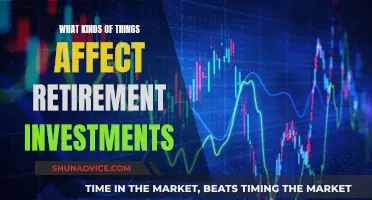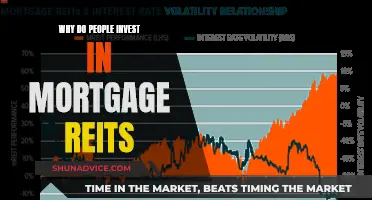
There are many options for things to invest in right now, depending on your risk tolerance, time horizon, and financial situation.
If you are looking for low-risk investments, you might consider U.S. Treasury Bills, Notes and Bonds, Series I Savings Bonds, or Treasury Inflation-Protected Securities (TIPS). These options are backed by the U.S. government and offer low to moderate returns.
For those with a higher risk tolerance, investing in stocks, exchange-traded funds (ETFs), or mutual funds might be a better option. These options offer the potential for higher returns but come with greater risk.
Other investment options include high-yield savings accounts, certificates of deposit (CDs), money market mutual funds, corporate bonds, and real estate.
When deciding what to invest in, it's important to consider your financial goals, risk tolerance, and time horizon. It's also crucial to understand the risks and potential returns associated with each investment option.
| Characteristics | Values |
|---|---|
| Savings accounts | High-yield |
| Certificates of deposit (CDs) | Long-term |
| Bonds | Corporate, government, municipal, treasury |
| Mutual funds | Money market, stock, index |
| Exchange-traded funds (ETFs) | S&P 500, Nasdaq-100 |
| Stocks | Dividend, value, small-cap |
| Real estate | Rental housing, REITs |

High-yield savings accounts
- Interest Rates: High-yield savings accounts typically offer interest rates that are significantly higher than the national average. As of July 2024, the best high-yield savings accounts offer annual percentage yields (APYs) of around 5% or more, while the national average savings rate is below 0.5%.
- Safety: High-yield savings accounts are generally very safe because they are insured and secured by financial institutions. Your deposits are protected up to a certain limit by the Federal Deposit Insurance Corporation (FDIC) or the National Credit Union Administration (NCUA).
- Accessibility: High-yield savings accounts provide easy access to your funds. However, there may be limitations on the number of withdrawals you can make each month, typically up to six transactions per month without incurring fees.
- Fees: These accounts usually have minimal or no monthly maintenance fees. However, there may be fees for certain transactions, such as wire transfers or excessive withdrawals.
- Requirements: Some high-yield savings accounts have minimum deposit requirements, while others have no minimum balance requirements. It's important to read the fine print and understand the requirements before opening an account.
- Compounding Interest: High-yield savings accounts allow your savings to grow through compounding interest. This means you earn interest not only on your initial deposit but also on the interest accumulated over time.
- Online and Mobile Banking: Many high-yield savings accounts are offered by online banks or the online divisions of traditional banks. These accounts often provide user-friendly mobile platforms and tools to help you manage your savings.
- Customer Service: Customer service options may vary depending on the financial institution. Some offer 24/7 phone support, while others provide additional options like chat or email support.
- Opening an Account: When opening a high-yield savings account, you will need to provide personal information, such as your Social Security number, and may need to meet minimum deposit requirements. You can often apply online or through a mobile app.
Savings Indirectly Matched with Investors
You may want to see also

Certificates of deposit (CDs)
CDs typically have terms ranging from 3 months to 10 years, during which you cannot withdraw your money without incurring a penalty. This makes CDs ideal for those who want to save for a specific goal or project and don't need immediate access to their funds. The fixed-rate nature of CDs also makes them attractive to risk-averse investors who prefer predictable returns.
When considering a CD, it's important to compare different offers by looking at the term, interest rate, and early withdrawal penalties. The best CD rates are usually found at online banks and credit unions, and they can be three to four times higher than the national average rate.
While CDs offer stability and safety, there are some potential drawbacks. Locking your money into a CD means you may miss out on higher interest returns if the federal funds rate increases during the term. Additionally, inflation can erode the value of your investment over time, resulting in lower real returns.
Overall, CDs can be a good investment option for those seeking stable and predictable returns without taking on the risk and volatility of the stock and bond markets.
Starbucks: A Brew Worth Betting On
You may want to see also

Bonds
Government Bonds
Government bonds are loans to a government entity, such as the federal or municipal government. They are considered a safe investment as they are backed by the full faith and credit of the government. While these bonds offer a steady stream of payments, the returns may not be as high as other investments. Government bonds are ideal for conservative investors who prefer less volatility in their portfolio. They are common among investors nearing retirement or those already retired, as they may not have a long investment horizon to weather potential market declines.
Corporate Bonds
Corporate bonds operate similarly to government bonds, but the loan is made to a company rather than a government. These bonds are not backed by the government, making them riskier. The risk and return depend on the likelihood of the company defaulting on its debt. Higher-risk corporate bonds tend to offer higher yields. Corporate bonds are suitable for investors seeking fixed-income securities with potentially higher returns than government bonds.
Bond Funds
Bond funds are diversified investments that hold a variety of bonds, providing investors with exposure to multiple bonds in one purchase. They can be purchased from a broker or directly from the underwriting investment bank. Bond funds offer the advantage of diversification, reducing the impact of any single bond on the portfolio.
Investment-Grade Corporate Bonds
Investment-grade corporate bonds are considered attractive due to their relatively high yields and low to moderate credit risk. The average yield of the Bloomberg US Corporate Bond Index was 5.6% in November 2023, a level rarely seen in the last 14 years. These bonds are suitable for investors seeking higher yields without taking on excessive risk.
High-Yield Corporate Bonds
High-yield corporate bonds, also known as junk bonds, offer substantial returns but carry higher risks. The average yield of the Bloomberg US Corporate High-Yield Bond Index was near 8.4% recently. These bonds are suitable for investors who can tolerate volatility and are willing to hold their investments for the long term.
In summary, bonds can be a good investment option for those seeking a relatively safe and stable income stream. The specific type of bond chosen will depend on the investor's risk tolerance and return expectations. It is important to carefully consider the risks and potential returns associated with each type of bond before making an investment decision.
Invest Wisely: Picking the Right Path
You may want to see also

Stocks
When it comes to stocks, there are a few options that could be considered good investments at the moment. Here are some detailed suggestions:
The "Magnificent Seven" Stocks
The Magnificent Seven stocks refer to Apple (AAPL), Microsoft (MSFT), Alphabet (GOOGL), Amazon (AMZN), Nvidia (NVDA), Meta Platforms (META), and Tesla (TSLA). These stocks lived up to their name in 2023 with impressive gains and continue to be among the best stocks to watch today. Due to their significant market capitalizations, they hold a substantial influence on the market-cap-weighted Nasdaq composite and S&P 500 indexes.
Meta Platforms (META)
Meta Platforms, the parent company of Facebook, Instagram, and other platforms, is a good investment option. It has attractive growth opportunities, an improving margin trajectory, and a compelling valuation. Meta's cost-cutting measures, coupled with increasing digital ad spending, will help expand margins and grow earnings and free cash flow. Analysts project an impressive $50 billion in 2024 FCF. Its focus on Reels, AI technology, and the metaverse makes it a promising investment.
Microsoft (MSFT)
Microsoft, the world's largest software company, is another solid choice. Its transition to a cloud-based business model and its industry-leading AI technology, including investments in ChatGPT-maker OpenAI, will drive growth. The cloud versions of its programs, such as Office and Teams, are gaining traction, and there are opportunities to further monetize its offerings. CFRA has a "strong buy" rating and a $455 price target for MSFT stock.
Nvidia (NVDA)
Nvidia, a top-performing stock in the market, is an excellent option for those seeking AI chip sales exposure. The widespread adoption of AI technology will be a massive tailwind for Nvidia's AI chip sales. With a 239% gain in 2023, making it the best-performing stock in the S&P 500, Nvidia is a strong contender for those looking to invest in stocks.
Alphabet (GOOGL)
Alphabet, the parent company of Google and YouTube, is another attractive investment opportunity. It can likely sustain annual revenue growth of 6% to 11% through 2025. Its free cash flow potential and attractive valuation make it a good pick. Alphabet's industry-leading AI technology can be applied to produce new enterprise AI tools, improve its Google Cloud business, and enhance search and YouTube efficiencies. CFRA has a "buy" rating and a $166 price target for GOOGL stock.
Amazon (AMZN)
Amazon, the market leader in e-commerce and public cloud services, is well-positioned to generate massive cash flows and profits for investors. It is generating high growth in its high-margin businesses, including third-party fulfillment, Amazon Web Services, and advertising. Amazon also has opportunities to improve efficiency by integrating robotics and increasing automation. CFRA has a "buy" rating and a $198 price target for AMZN stock.
Other Options
Other stocks to consider investing in right now include Granite Construction (GVA), Universal Health Services (UHS), and Booking (BKNG). These stocks boast impressive relative strength and strong overall performance. Additionally, Goldman Sachs (GS) and Spotify Technology (SPOT) are also worth considering, with "buy" ratings from Bank of America and promising growth prospects.
NPS: Invest Now or Miss Out
You may want to see also

Mutual funds
When choosing a mutual fund to invest in, there are several factors to consider. Firstly, look for funds with a transparent and disciplined investment strategy, managed by experienced professionals. Secondly, consider the fund's expense ratio, assets under management, trading volume, level of diversification, portfolio turnover, track record, and strategy.
- Fidelity 500 Index Fund (FXAIX): This fund has a very low expense ratio of 0.015%, no minimum investment or transaction fees, and a long track record dating back to 1988. However, it has no exposure to small-cap or international stocks and a high concentration in the technology sector.
- Fidelity Total Market Index Fund (FSKAX): This fund addresses the criticism that the S&P 500 doesn't accurately represent the entire US stock market by tracking the Dow Jones US Total Stock Market Index, which includes small-cap stocks. It has a low expense ratio of 0.015% and a low turnover rate of 2%. However, it has historically underperformed FXAIX slightly and has no exposure to international stocks.
- Schwab S&P 500 Index Fund (SWPPX): This fund is a good option for investors using the Charles Schwab brokerage platform. It has no minimum investment, a low expense ratio of 0.02%, and a portfolio turnover rate of just 2%. However, it has no exposure to small-cap or international stocks and a high concentration in the technology sector.
- Schwab Total Stock Market Index Fund (SWTSX): Like FSKAX, this fund offers a broader alternative to the S&P 500 by tracking the Dow Jones US Total Stock Market Index, which includes small-cap stocks. It has a low expense ratio of 0.03%, no minimum investment, and a low turnover rate. However, it has slightly underperformed SWPPX and has no exposure to international stocks.
- Vanguard 500 Index Fund Admiral Shares (VFIAX): This fund has a long track record dating back to 2000 and massive assets under management. It has a relatively low expense ratio of 0.04%, a low portfolio turnover of around 2%, and tracks the S&P 500 index. However, it has no exposure to small-cap or international stocks and a high concentration in the technology sector.
- Vanguard Total Stock Market Index Fund Admiral Shares (VTSAX): This fund holds over 3,800 stocks by tracking the Spliced Total Stock Market Index, a variant of the Dow Jones US Total Stock Market Index. It has a low expense ratio of 0.04%, a low turnover rate of 2%, and includes small-cap stocks. However, it has slightly underperformed VFIAX, has no exposure to international stocks, and a high concentration in the technology sector. Additionally, it requires a $3,000 minimum initial investment.
Commodities: Invest Now or Later?
You may want to see also







